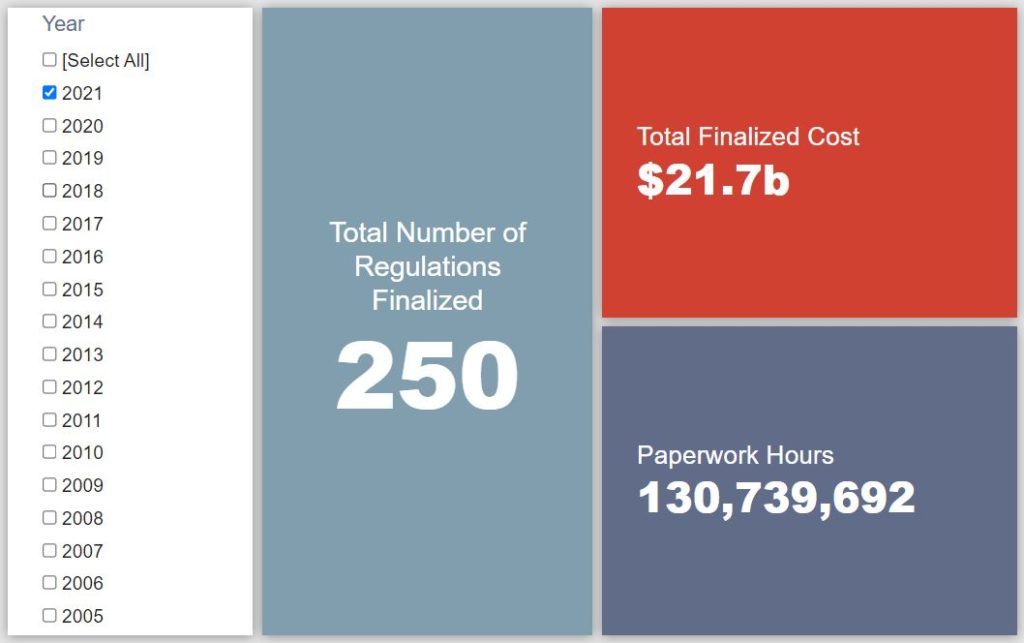Week in Regulation
December 6, 2021
A Modest Start to December
Last week was a relatively ho-hum one in terms of notable regulatory activity. With only nine rulemakings with some measurable economic impact estimate, there were limited chances for any game-changing actions. Of note, however, the two most significant rules of the week came from different sub-agencies under the Department of Health & Human Services (HHS). Across all rulemakings, agencies published $181.2 million in total net costs and added 215,068 annual paperwork burden hours.
REGULATORY TOPLINES
- Proposed Rules: 29
- Final Rules: 67
- 2021 Total Pages: 68,766
- 2021 Final Rule Costs: $21.7 billion
- 2021 Proposed Rule Costs: $192.3 billion
NOTABLE REGULATORY ACTIONS
The most significant rule of the week came from the Food and Drug Administration (FDA). Its final rule regarding “Laboratory Accreditation for Analyses of Foods” would, as the title suggests, “establish a program for the testing of food in certain circumstances by accredited laboratories.” In particular, the rule sets the standards by which a laboratory becomes duly certified as Laboratory Accreditation for Analyses of Foods (LAAF) compliant. FDA estimates that the costs involved with establishing this LAAF certification process could range from $38 million to $66 million, with a mid-point estimate of $52 million.
The runner-up for the week came from another branch of HHS, the Administration for Children and Families (ACF). This rule also has a relatively straightforward title: “Vaccine and Mask Requirements To Mitigate the Spread of COVID-19 in Head Start Programs.” Similar to some of the Biden Administration’s recent administrative actions on vaccinations, this rule requires “universal masking for all individuals two years of age and older, with some noted exceptions, and all Head Start staff, contractors … and volunteers working in classrooms or directly with children to be vaccinated for COVID-19 by January 31, 2022.” ACF estimates that implementing these requirements in coming months would cost affected entities roughly $49.5 million.
TRACKING THE ADMINISTRATIONS
As we have already seen from executive orders and memos, the Biden Administration will surely provide plenty of contrasts with the Trump Administration on the regulatory front. And while there is a general expectation that the new administration will seek to broadly restore Obama-esque regulatory actions, there will also be areas where it charts its own course. Since the AAF RegRodeo data extend back to 2005, it is possible to provide weekly updates on how the top-level trends of President Biden’s regulatory record track with those of his two most recent predecessors. The following table provides the cumulative totals of final rules containing some quantified economic impact from each administration through this point in their respective terms.
![]()
While the final rules discussed above only provided modest shifts in the Biden Administration’s regulatory tallies, there was some significant movement around this time for each of its recent predecessors. The Trump Administration saw a roughly $2.5 billion decrease in its cost total as December 2017 began. The primary driver of this shift was that administration’s rule delaying the effective date of the Obama-era “fiduciary rule.” The Trump-era Department of Labor estimated that putting that rulemaking on hold would save $2.2 billion. For the Obama Administration, the major shift around this time in 2009 was a cost-increasing rule, specifically,an Environmental Protection Agency rule regarding “Effluent Limitations Guidelines and Standards,” with total costs of nearly $6.1 billion.
THIS WEEK’S REGULATORY PICTURE
This week, the Department of the Treasury offers to streamline requirements for makers of distilled spirits.
 Source: Photo by Nick Rickert on Unsplash
Source: Photo by Nick Rickert on Unsplash
In the December 3 edition of the Federal Register the Alcohol and Tobacco Tax and Trade Bureau (TTB) published a proposed rule that would ease certain requirements for distilled spirits plants.
The proposal stems from a nearly five-year effort initiated by an internal TTB review of its own data and bolstered by a broader Treasury Department request for public input on possible deregulatory actions that would streamline federal requirements.
In the notice, TTB proposes several changes to its regulations for distilled spirits plant permits, which persons (or entities) must apply for prior to starting operations and update when making certain alterations. A major change is the elimination of several statements describing operations, production procedures, storage systems, and more. TTB justifies the proposal by explaining that its internal review found much of this information is not actually needed to determine whether an applicant is qualified.
Similarly, TTB is proposing to change the current open-ended question on the application asking for a description of a plant’s security with more direct questions that the agency expects will be easier and less time consuming to answer. Another proposed change is to extend the current 30-day deadline for reporting certain changes to the plant to 60 days – a change that stems from comments from industry that 30 days was too tight a timeframe to compile the needed information.
While TTB does not quantify the time savings in its proposal, it does state that the changes will “significantly reduce the time needed to complete an application for a permit.” In the notice, TTB also indicates more changes may be coming to other areas of alcohol production under its jurisdiction due to its deregulatory reviews – including for wine and beer producers – in future rulemakings.
TOTAL BURDENS
Since January 1, the federal government has published $214 billion in total net costs (with $21.7 billion in new costs from finalized rules) and 138.8 million hours of net annual paperwork burden increases (with 130.7 million hours in increases from final rules).












